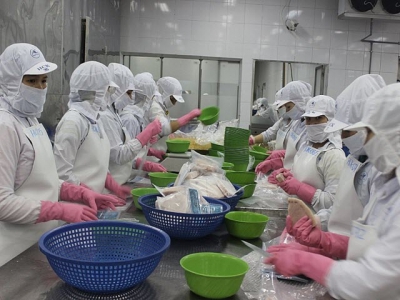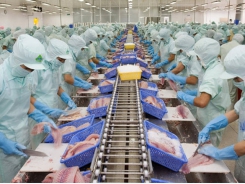It is recommended to choose one of two forms of aquatic quarantine

Fishery firms propose to choose the form of quarantine of imported goods between two forms: quarantine at the firm's warehouse or quarantine at the port and then bring the goods to the warehouse to await customs clearance.
Seafood businesses will be supported
To support Vietnamese seafood firms to overcome the Covid-19 pandemic, improve competitiveness and be able to maintain and develop export production, the Vietnam Association of Seafood Exporters and Producers (VASEP) summarised the problems of firms and proposed a number of contents.
Related to quarantine problems while the relevant circulars have not been amended and supplemented (Circular 36/2018/TT-BNNPTNT, Circular 26/2016/TTBNNPTNT and Circular 15/2018/) TT-BNNPTNT) of the Ministry of Agriculture and Rural Development (NNPTNN), there should be directions and instructions to allow firms, depending on their actual conditions, to choose a quarantine form (import inspection) between the two method: quarantine at firms' warehouses; or quarantine at the port and then bring goods to a warehouse for storage and wait for customs clearance.
In addition, a representative of VASEP suggested in the context of the difficult situation of the Covid-19 pandemic and reforms to support production and business, the Ministry of Agriculture and Rural Development should direct border veterinary agencies to strengthen timely inspection for the imported shipment to the firm in the form that the firm chooses (at the warehouse, or at the port).
Regarding problems in putting processed products from animals, aquatic animal products used as food on the list of imported quarantine, it is proposed the Ministry of Agriculture and Rural Development does not issue the inspection of imported aquatic products used as food for human consumption (frozen, dried, canned, cooked, ready-to-eat) are included in the list named quarantine - except for raw, fresh and chilled products.
Imports of the above products for use as food have been inspected and imported by the Department of Animal Health in accordance with food safety criteria and international practices and scientific basis. It is necessary to return the correct name, correct concept and correct regulations in the relevant circulars of the Ministry of Agriculture and Rural Development. It is a State inspection of food safety, not a quarantine as named in Circulars 36/2018/TT-BNNPTNT, Circular 26/2016/TTBNNPTNT and Circular 15/2018/ TT-BNNPTNT. Then, the inspection of imported food safety must comply with the mechanism and method in Decree 15/2018/ND-CP guiding articles of the 2010 Law on Food Safety.
According to VASEP, animal products or products containing aquatic “animal products” (frozen, dried, canned, cooked, ready-to-eat) are on the list of subject to quarantine specified in the Circulars on “quarantine” of the Ministry of Agriculture and Rural Development. of which, most and mainly (by volume) are frozen aquatic products used as food.
It is worth mentioning the list of goods subject to "quarantine" according to the provisions of three circulars is very wide. Imported containers are subject to 100% inspection (documentation and sensory inspection) regardless of the purpose of import (processing export goods or domestic consumption). Sampling is applied when there is doubt for goods imported for export, export clearance and 20% of lots per year for goods imported for domestic consumption.
The above regulation leads to a large scale and number of items and consignments subject to "import inspection" today, with tens of thousands of items. According to data announced by the TFP Project at the Workshop to comment on the draft amendment to Circular 15/2018/TT-BNNPTNT (on H/S codes of goods subject to import inspection), the total number of items under management Vietnam's specialised inspection (13 ministries- in the 10 months of 2020) is 70,087 items, of which the Ministry of Agriculture and Rural Development has 57,562 items, accounting for 82.13% of the total.
According to the statistics and publication of the TFP Project, the number of violated shipments during the quarantine in the past years is extremely low (in 2017: only four out of total 320,376 declarations were violated, accounting for 0.001%; In 2018: only 6/total 183,831 declarations were violated, accounting for 0.01%. In 2019: zero of the total 320,376 declarations were violated, accounting for 0%). Meanwhile, the quarantine requirements, the frequency of quarantine and the number of consignments subject to quarantine gradually increased from 2010 to present.
The maintenance of objects and lists of "processed goods for use as food" subject to quarantine over the years and in draft amendments to Circular 15/2018/TT-BNNPTNT is an excessive measure and is not suitable for the owner to reduce the list of goods subject to specialised inspection, in accordance with international laws and practices.
Related news
Tools

Phối trộn thức ăn chăn nuôi

Pha dung dịch thủy canh

Định mức cho tôm ăn

Phối trộn phân bón NPK

Xác định tỷ lệ tôm sống

Chuyển đổi đơn vị phân bón

Xác định công suất sục khí

Chuyển đổi đơn vị tôm

Tính diện tích nhà kính

Tính thể tích ao



 Early mortality syndrome hits farmed shrimps again
Early mortality syndrome hits farmed shrimps again  Seafood exports to lose up to US$ 500…
Seafood exports to lose up to US$ 500…